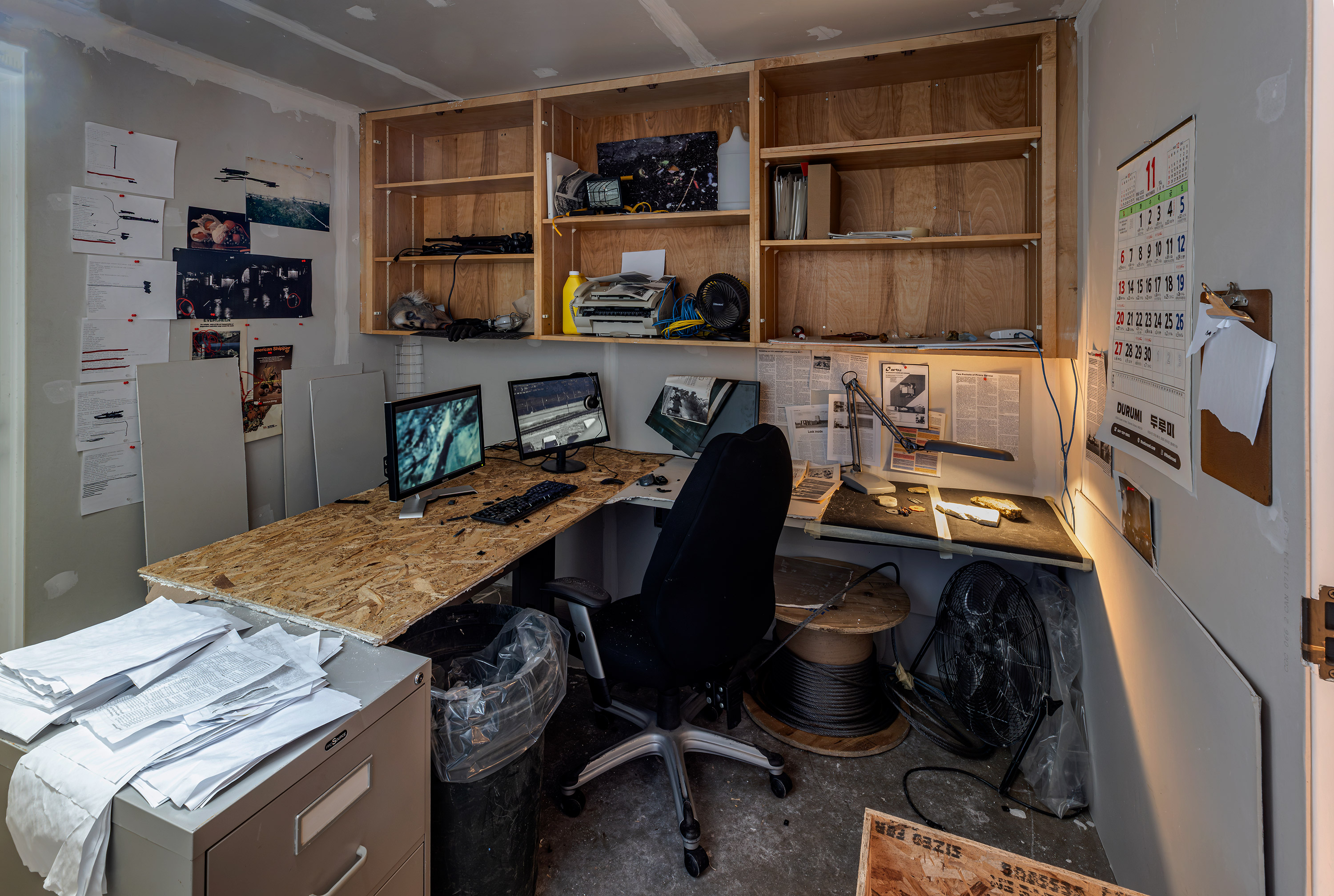Salvage Archives Meets The Listeners in “Curated Pages,” KWAG’s Member Book Club.
Written by Morgan Anderson, Development Coordinator of the Kitchener-Waterloo Art Gallery.
23 April was World Book Day, 24 April the Gallery hosted a “Reading Rave,” and 26 April was Indie Bookstore Day. April was a great month for readers! To celebrate, we’re sharing with you a Reading/Viewing Guide for the Spring edition of our Members-Only book club that puts Miles Rufelds’ video installation Salvage Archives (curated by Darryn Doull and on display at KWAG until 25 May) in conversation with Jordan Tannahill’s book The Listeners (shortlisted for the 2021 Giller Prize). Both pieces are works of parafiction that blur the lines between fact and fiction to tell the stories of two unwitting conspiracy theorists: “C” in Salvage Archives and “Claire” in The Listeners.

Salvage Archives follows an unemployed C as he learns that when cargo ships are delayed, buyers are left without a market and will abandon their contracts. The containers are then auctioned off to a secondary market, which C believes could be quite profitable. Instead of starting his own independent “salvage buying” business, though, C finds salvage buying message boards filled with paranoiacs and conspiracy theorists. Despite “knowing the type,” C believes there might be something real going on here. The mixtures of objects left behind on the shores of the Great Lakes are too inexplicable. He starts a Twitch stream and a Youtube channel to document his salvage archive. He gains a following and makes his living off donations from them. We won’t give away the ending—you’ll have to visit KWAG to learn what happens!
Spliced between C’s narrative are lectures from a historian called “H.” H’s accounts of industrial farming, of surpluses and distribution patterns, sound much more academic than C’s memoir-like ones; however, Angel Callander, in her exhibition essay, claims that they too obscure the truth. It begs the question: are all conspiracists people who are "socially and economically isolated” (Callander 5)? Or are there others that turn to conspiracy when they are “desperately if subconsciously searching for an answer as to why" (5)?

The Listeners Summary
The Listeners by Jordan Tannahill offers a kind of answer to this question. Claire is a loving wife and mother, an atheist, and a fully employed high school teacher. One night, Claire starts to hear a constant humming and is determined to find its source. She starts by interrogating every possible sound in her house: "security alarms, fire detectors, carbon monoxide detectors, Wi-Fi, thermostat controls, all of the systems animating the body of our house, unnoticed and unappreciated like breathing or circulation" (Tannahill 11). But the hum continues, its source unidentifiable. She starts getting nose bleeds, migraines, she can’t sleep—that is, until she forms unlikely friendships with a community of neighbours who can also hear the hum. The Listeners is told in the style of memoir and draws from a real phenomenon that has been documented and speculated about across the globe. Is it Claire’s “forceful and dismissive” atheism and skepticism of all things unscientific that ironically makes her more susceptible to conspiracy? Is her subconscious mind searching for a meaning to life that her conscious mind won’t let her entertain?
Salvage Archives and The Listeners in Conversation
When the truth becomes malleable or erodes—as it has in an age of “fake news,” deep fakes, misinformation, etc.—so too do our institutions. In Claire’s case the institutions of family and marriage have eroded, but she also develops a mistrust of medical institutions as her fellow “hummers” argue that her medicalization only benefits those who can’t hear the hum; it’s easier to “contain and mute” than hear the truth (128). That said, it seems equally true that when our institutions erode, so too do our truths. Conspiracy theories like C’s and Claire’s come from very real fears that we can’t trust the institutions that govern our lives. "Politics,” Callander writes, “succeeds greatly in abstracting human life... increasingly, decisions made have little to do with the material impacts they will have on real people,” and this lack of transparency can be disconcerting (5).
In what follows, our Development Coordinator, Morgan Anderson, poses questions for reading/viewing that put Salvage Archives and The Listeners in conversation with each other. To access future guides that pair KWAG’s exhibitions with contemporary literature, and other engaging resources, join KWAG’s membership for as low as $50/year!
Questions for Readers/Viewers (spoilers ahead!)
1. Angel Callander's exhibition essay is titled "Unreliable Narrating." She argues that both characters in Salvage Archives are unreliable narrators: H is apparently more reliable as she draws on "historical accounts of agriculture and industrial farming... surpluses and distribution patterns" but: "much is missing" (5). In The Listeners, Claire spends a lot of time assuring us that she isn't a conspiracy theorist. Can we rely on her account, though? Why might Claire be an unreliable narrator, or not?
2. Both Tannahill and Rufelds’ works are framed as memoir and rely heavily on research of real-world phenomena. How do these artists’ use of parafiction as a genre affect your understanding of their texts, or of conspiracy theories themselves?
3. Message boards are "supposedly social and connective while remaining untethered from official channels of disseminating information (which are easily compromised)" (Callander 5). Both Claire and C turn to message boards. What does Claire get from the hummers that she doesn't from her family and friends (129)? What does she get out of Howard's group that she doesn't out of mainstream outlets like police or journalists? What does C get out of his Twitch and YouTube streams, and is it different from what Claire has found with an in-person group?
4. Rufelds turned the film viewing experience into something more theatrical by placing the film within an installation and in the film C claims that, "The new age is a stage or a film set." Tannahill is primarily a playwright and his book was written to inspire an opera. Why do you think there is so much overlap with theatre/staging and conspiracy in these two pieces? How might the mediums of film, installation, literature, and opera each lend different perspectives to the topic?
5. Tannahill’s protagonist is decidedly left-wing politically, while Rufelds is perhaps more politically ambiguous if not left-leaning. Contemporary conspiracy theorists tend to be more right-wing, though, as Claire points out of Damian in The Listeners (173). Why do you think Tannahill and Rufelds chose these left-wing or politically ambiguous protagonists instead of conforming to a stereotype?
6. As Claire meets others that hear the Hum, she profiles them by stereotyping, judging, gossiping, and making assumptions (91). What might Tannahill be trying to say about the parallels between conspiracy and seemingly harmless gossip in these depictions? What assumptions did you make about C in Salvage Archives, whose psychology we don’t get as much insight into as Claire’s in The Listeners?
7. Nora isn't allowed to leave the house at the end of The Listeners. In Salvage Archives, C accepts money from his followers to fuel the conspiracy. At what point does conspiracy turn over into cult?
8. "Sounds can cause damage," Kyle claims in The Listeners (42). In reading this line, I am reminded of the way the news can become a background hum—a constant listing of the world’s worst atrocities, so never-ending and distanced from those atrocities that little emerges as more awful or urgent than anything else. It can be tempting to simply tune out the hum and live in ignorance, rather than stand up for what is right. Sounds may cause damage, but not listening to them can, too. What else might the Hum be a metaphor for in The Listeners? What might the salvage archives be a metaphor for in Salvage Archives?
Images:
Reading Rave photos by Annie Gabrielse (feature image and header).
Miles Rufelds, Salvage Archives, 2025. Installation, digital video with sound, 43:00 mins. Installation view from Kitchener-Waterloo Art Gallery, 8 February – 25 May, 2025. Photos by Toni Hafkenscheid.
Curated Pages graphic by KWAG using the cover of the book The Listeners by Jordan Tannahill. Published in Canada by HarperCollins Canada on August 17, 2021.





